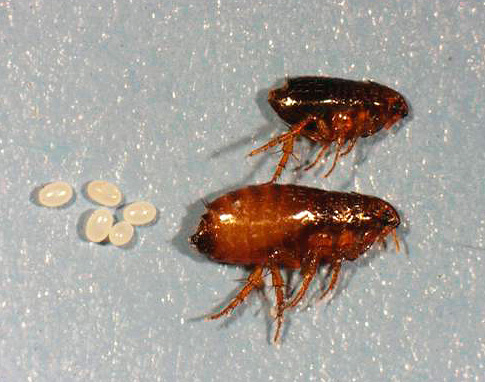
Fleas are parasites without a particularly narrow specialization in terms of choosing their prey. They bite humans the same way as other animals, although most species of fleas still prefer to bite their natural hosts.
For example, for dog flea it is the dog and the kinds of animals that are close to the dogs — foxes and wolves — that are most suitable. And fleas in humans appear when the two-legged host is near a hungry insect.
Few people know, but there is a real human flea. The one for which the main and most preferred source of food is a person. This insect is quite a bit different in appearance and way of life from its relatives, but, like other jumping parasites, it does not live permanently on humans.
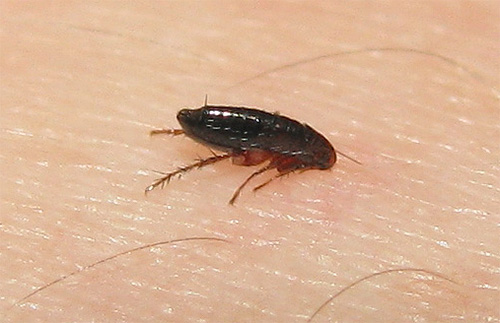
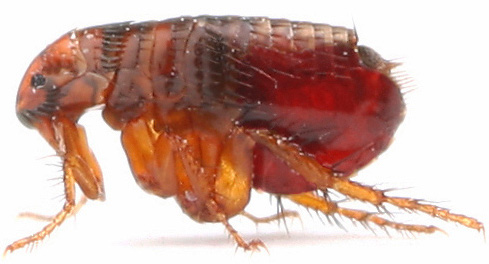
It is interesting
A common misconception: some think that fleas live on humans or animals all the time. In fact, it is not.The life cycle of a flea does not imply its permanent dwelling on the host's body, and flea larvae generally do not develop on the surface of a warm-blooded body.
Human flea and its bites: a detailed description
Human fleas are quite large compared to their relatives (other flea species). The body length of an adult insect is about 3 mm. With such dimensions, the parasite can jump a distance of up to half a meter in length.
On the photos below, adult human fleas are visible: the dark brown color of their body is clearly visible and it is clear that they have no wings.
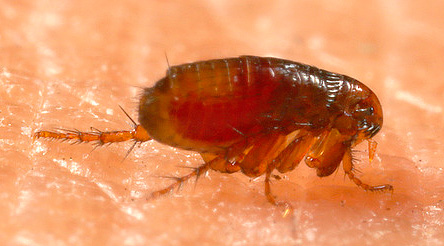

From other parasites of a person, these bodies differ in body obliquely from the sides: this form helps them to easily move among the hairs in the head and not be crushed when they catch or brush their bites.
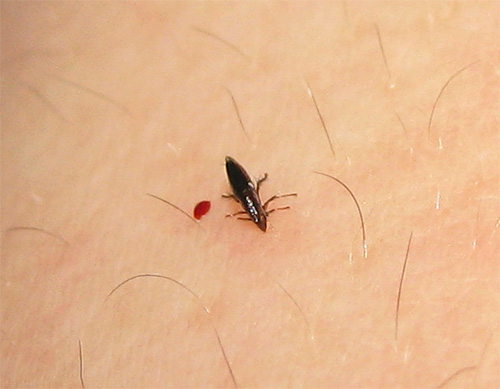
On a note
Lice and fleas in humans are often found in similar places - where the body is covered with hair. But at the same time, the lice are very inactive and sit mostly on the hair, and the fleas are almost imperceptible and move along the skin.
Human fleas from dogs or cats with the naked eye are practically indistinguishable. Only an entomologist can, by an enlarged photo or under a microscope, distinguish one species from another.
At first glance, human fleas look like small brown grains on the body or on the floor.Insects in them gives movement. A person is not able to see a flea at the moment of a jump: a glance marks only an insect present in one place and in the next moment its disappearance.

It is interesting
The appearance of human fleas was studied in detail in the Middle Ages. There are numerous pictures depicting these insects, mentioning them in the writings of scientists. Like the bugs, these parasites disturbed the person especially strongly, and therefore attracted close attention at all times.
Unknown people often confuse flea larvae with fly maggots. They are very small - several millimeters in length - white, have a worm-like body shape and live mainly in heaps of organic remains.
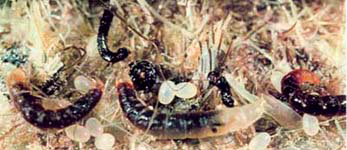
The photo below shows the flea larva with multiple magnification:
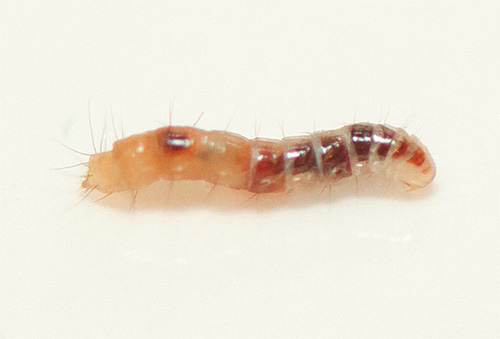
Adult fleas feed exclusively on the blood of warm-blooded animals. There are only a few species of these parasites that can eat and blood of reptiles. The main owner of the human flea is the man, but in the absence of it, it successfully attacks dogs and cats.
The photo shows a feeding insect: due to the lack of a special proboscis, she is forced to immerse her head deep into the integuments of the host's body:

An adult insect spends most of its life in secluded places that are as close as possible to places of constant human presence. Here the parasites breed, and here their larvae develop, feeding on either decaying organic debris or adult flea excrement.
When they get hungry, fleas jump on people or animals that appear nearby, pierce their skin and suck blood from a blood vessel. After saturation, the parasite immediately tries to leave the body of the host. In fact, these insects do not live on the human body (unlike, for example, lice), and the expression “fleas in humans” and the question “are there fleas in humans?” Are not quite correct.
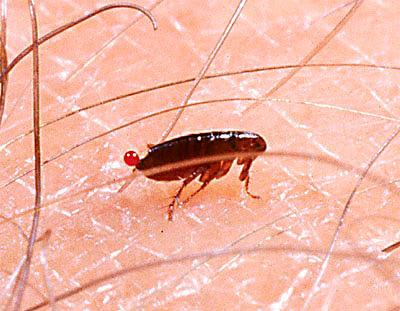

It is interesting
From an evolutionary point of view, fleas as parasites are of great interest to scientists. If other parasites of the type of bugs have learned to make their bites painless at the expense of special enzymes, the fleas "do not worry" about this: their shots are very, very sensitive. But then, a person cannot crush even a well-fed flea with his fingers: natural selection has already helped parasites to become less vulnerable due to the loss of wings and flattening of the body.
An adult flea lives on average for several months, although theoretically it can live to a year and a half. According to scientists, in one lifetime, one insect can become a parent for 500 direct descendants and more than a few tens of thousands - “grandchildren” and “great-grandchildren.”
It is interesting
Judging by the palaeological data, before the appearance of a human on the planet, human fleas lived in the territory of modern South America and parasitized on the local pigs and large rodents.
The human flea is very similar to its other relatives by its universality: it can attack many warm-blooded animals. No less than other types of these parasites easy jump on the person. Therefore, having met a flea on your body, one can never definitely say that it is a human flea.
What other fleas attack humans
In addition to the human flea, more than 1,500 species of these parasites can potentially attack humans - almost all of those that are not rigidly tied to specific species of mammals and birds.
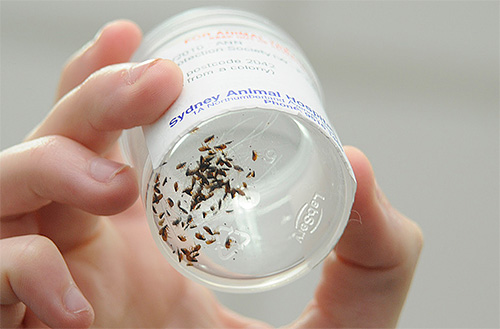
The following person most often bites flea species:
- feline - the most common
- doggy
- rat (carriers of the plague during the Middle Ages)
- rabbit, attacking most often in the wild.
At the same time, all these insects jump on people when their usual owners are not around. For example, rabbit fleas often bite hunters who find themselves near the burrows in a rabbit colony.
On a note
Hunters sometimes say that they were bitten by earthen fleas. In fact, human earth fleas do not bite: this is not even the name of a flea, but small herbivorous beetles that damage fields and orchards. Hunters usually bite flea from fox or rabbit holes.
The most painful bites for humans are caused by fleas parasitizing large herbivores. According to the testimony of the victims, the bites of large - up to 5 mm - elk fleas more painful than even bee stings.
What are dangerous fleas for humans?
The most frequent consequence flea bites is pulykoz - a set of symptoms that resemble allergies:
- abundant solid rash in the area of bites
- inflammations of the bites themselves, sometimes - suppuration
- appearance of sores in the mouth and throat
- swollen lymph nodes
- fever
- headaches, irritability, insomnia.
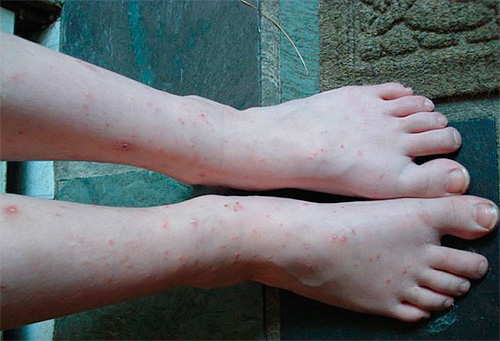
But much more dangerous to people are fleas becausethat are potential carriers of helminths and pathogens of the following diseases: plague, anthrax, encephalitis, trypanosomiasis. Scientists have discovered more than 200 viruses, bacteria and protozoa that can cause deadly human diseases in the organisms of various species of these parasites.

Of course, not every flea bite will reward you with a similar disease. But remember the potential danger of such bites is always necessary.
Flea Remedies
The fight against fleas - it is always getting rid of them an apartment or house. It makes no sense to catch and destroy the parasites on yourself, it will not help.
To get rid of human fleas in an apartment can be in different ways:
- pickle the room with a special insecticidal spray. Raptor, Raid, Combat aerosols and the Hangman insect repellent have proven themselves in this regard.

- Use insecticidal contact powders. They will help get rid of flea larvae.
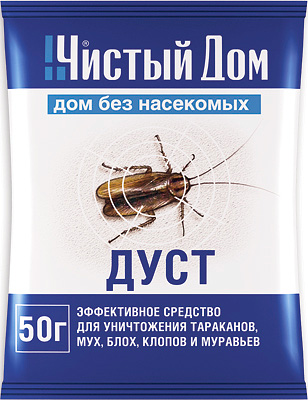
- Or call a brigade to destroy parasites - this is the most reliable, but also an expensive way to get rid of fleas.

Separately, it should be said about the flea larvae. For their destruction, special dusts, which are used for breeding cockroaches, are well suited (for example, dust "Clean house", Powder" Pyrethrum "and others).
After ridding the home of insects, it is important to maintain cleanliness in the room and observe preventive measures against the infiltration of parasites into it.
The treatment of human flea bites consists of treating the bite sites with antiseptic soap and alcohol solutions - green paint or iodine. With the development of puliosis or allergies, only a doctor can prescribe medications for the treatment of bites. These may be antihistamines, sedatives and drugs for symptomatic treatment.
On a note
There is no special flea shampoo for humans. Insecticidal shampoos for pets are produced for the reason that in their thick hair insects can survive even after swimming.
But protection from parasites in the field is necessary. For this you can use the popular sprays from insects. A good flea spray for humans must contain a sufficient amount of the substance DETA - a powerful insect repellent.
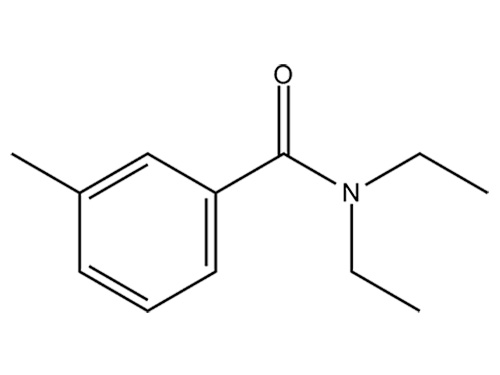
Among the most popular sprays that can scare off fleas, the following can be highlighted:
- Off Extreme, famous mosquito and mosquito repellent
- Biban - a reliable tool for almost all blood-sucking insects
- Gall rat
- Gardex, well proven in trials in the northern taiga.
On a note
From fleas, sprays are more effective than ointments. Due to their mobility, fleas can jump onto different parts of the skin, which are easier to treat with spray than with ointments or gels.
And, of course, to protect against fleas will help banal forethought. Do not iron dirty stray animals, visit premises that do not meet sanitary standards less often, and if you go to the nature, have long-sleeved clothes with you - this will be enough to protect yourself from bloodsuckers.
Useful video: different types of fleas under the microscope and methods of dealing with them

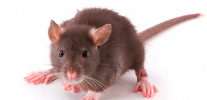

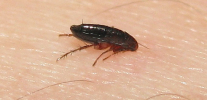
For some reason I used to think that fleas do not bite people. And here it is, it turns out. Good article!
And we hunted down seven times - with Katrina, and medilis tsiper, and with sinusan, and Jurex, and paragraph, and ... But nothing takes them. They were brought to our house by the Tajiks in the next apartment, now three reactifications are infected. How to be? ..
Wash the floor with an amwey loc. We and our friends so withdraw from the floor, and with cats and dogs. I do not know what is contained there, but they die from it.
Thanks for the article, I learned a lot of new things.
Damn, read. Now my head itches 😀
As always.